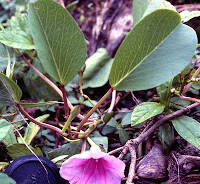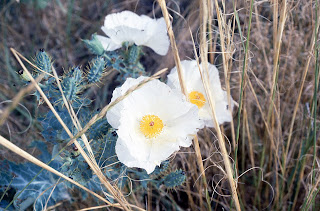 |
| View from Richardson Beach, Hilo, Hawaii |
 |
| almonds? on Mauna Kea Beach, Hawaii |
To look up answers to these questions I needed to know the name of the plant.
 |
| Plant identified with Hawaiian name |
One plunges Hawaiian plant identification to find they are called pohuehue, kukui, liliko’i...
Scientific names were created to cut through the confusion resulting from multiple languages. The idea is that each species has only one scientific name. The scientific name is in Latin for historic reasons--when the system was set up, in the 1750‘s, Latin was the language that unified educated Europeans. The system works today.
I can go from pohuehue to find that the plant's scientific name is Ipomoea pes-caprae, which in English is the beach morning glory.
 |
| pohuehue, Ipomoea pes-caprae, beach morning glory |
[Technical bit: foreign words in an English text are italicized. Both the Hawaiian common names and the scientific name, which is considered to be in Latin, are therefore italicized.]
Pohuehue is a favorite of mine: a plant with bright purple flowers found across the tropical beaches of the world. There are lots of morning glories, genus Ipomoea, most of them in the New World tropics. How did pohuehue get to Hawaii? By the seeds floating in from elsewhere, no doubt.
 |
| Ipomoea pes-caprae on a beach in Taiwan |
 |
| kukui, Aleurites moluccana, candlenut |
 |
| unidentified passion flower from Costa Rica |
 |
| banana poka, Passiflora mollissima, near Volcano, Hawaii |
Liliko’i is the edible passion fruit, also called passion flower, Passiflora edule. You can get liliko’i mousse in fine restaurants like Merriman’s. The passion fruits are native mainly to the Americas where most of the 351 species in the genus Passiflora live (plant family Passifloraceae). At least four have naturalized in Hawaii in the last 200 years, and one, banana poka, Passiflora mollissima, is a serious weed in wet forests. The name passion flower comes from the complicated flower, in which New World missionaries saw a whole series of Christian symbols. Because they are almost all vines with recognizably related, rather fantastic flowers and round fruits full of juice-covered seeds (most are not tasty) passion flowers are easy to identify.
I still don't know how the piece of kapa I saw in a museum was dyed pale purple. Perhaps what I saw was faded red from noni (Morinda sp.) or hibiscus dye, or a lavender from sea urchins.
Puka kala is Argemone glauca, called prickly poppy in English. It is--mysteriously to me--a close relative of and very similar to Argemone polyanthemos of the plains of central North America. Both are related to cultivated poppies, but not as closely as they are to each other. Both do have scary-looking thick yellow or yellow-orange colored sap. Prickly poppies are pretty toxic, although I can’t think who would want to bite through the spines to leaves that bleed yellow. How did it get to Hawaii? Unknown.
The almonds on the beach were false kamani, also called kamani haole and kamani ula. The scientific name is Terminalia catappa, in the combretum family, Combretaceae, a group of tropical trees and shrubs. "Real" almonds, Prunus amygdalus, (rose family, Rosaceae) are quite different and are related to apples and pears. False kamani is found on many tropical beaches and has been transplanted around the world. There were a number of them growing along the beach in Happy Grove, Jamaica, when I led a class field trip there in 1977. I discovered seedlings unfurling their first leaves in the beach drift of the shore and watched caterpillars as long as my hand munch their way through the thick leaves. False kamani is native to the tropical Pacific and its English common names are Indian almond, tropical almond and even the misleading name West Indian almond. My sources say the fruits are edible, worth remembering in case of shipwreck.
 |
| prickly poppy, Argemone polyanthemos in western Nebraska. The Hawaiian puka kala looks very like this |
 |
| tropical almond, Terminalia catappa seedling, Happy Grove, Jamaica December 1977. |
 |
| Caterpillar enjoying tropical almond leaves, Happy Grove, Jamaica, December 1977. |
References I consulted:
Baldwin, R. E. 1978. Hawaii's poisonous plants. Peterograph Press, Hilo.
Hall, J. B. 2004. A hiker's guide to trailsie plants in Hawai'i. Mutual Publishing, Honolulu.
Hall, J. B. 2004. A hiker's guide to trailsie plants in Hawai'i. Mutual Publishing, Honolulu.
Hargreaves, D. and B. 1964,. Tropical trees of Hawaii. Hargreaves Company, Inc., Honolulu.
Island Expat. http://hawaiiantimemachine.blogspot.com/2010/11/colors-of-kapa.html (accessed 3/15/13)
Kapa Hawaii. Kapa design elements and dyes. 2006-2012. http://www.kapahawaii.net/contact-kapa-hawaii.html Kapa Hawaii LLC. (accessed 3/17/13)
Little, E. J. Jr. and R. G. Skolmen, 1989, Agricultural Handbook no. 679 Common forest trees of Hawaii. Online 2003 (accessed 3/17/13) https://cms.ctahr.hawaii.edu/forestry/Forestry-Publications/Common-Forest-Trees-of-Hawaii (link updated 1/25/21)
Merlin, M. D. 1977. Hawaiian forest plants. Oriental Publishing Company, Honolulu.
Thank you so much for this article. I've been looking everywhere for the Hawaiian names of plants and this helped me find a website with tons of them. I really appreciate it.
ReplyDelete